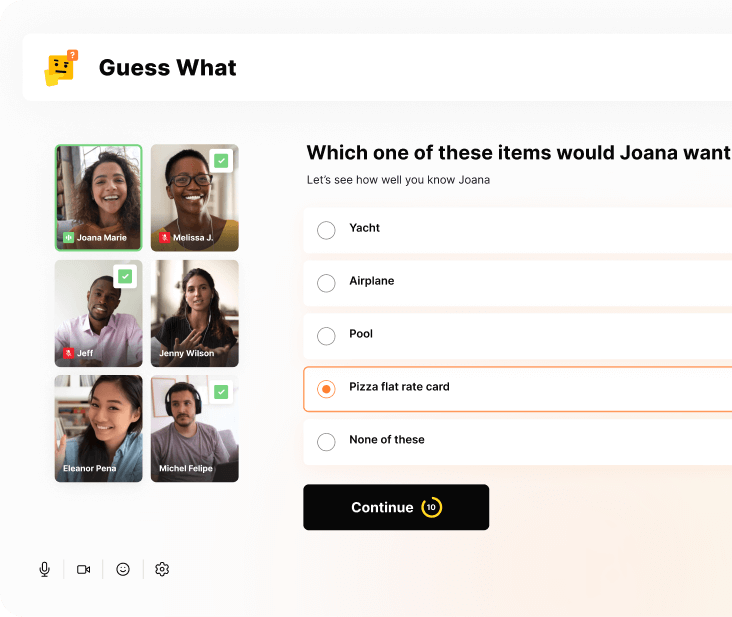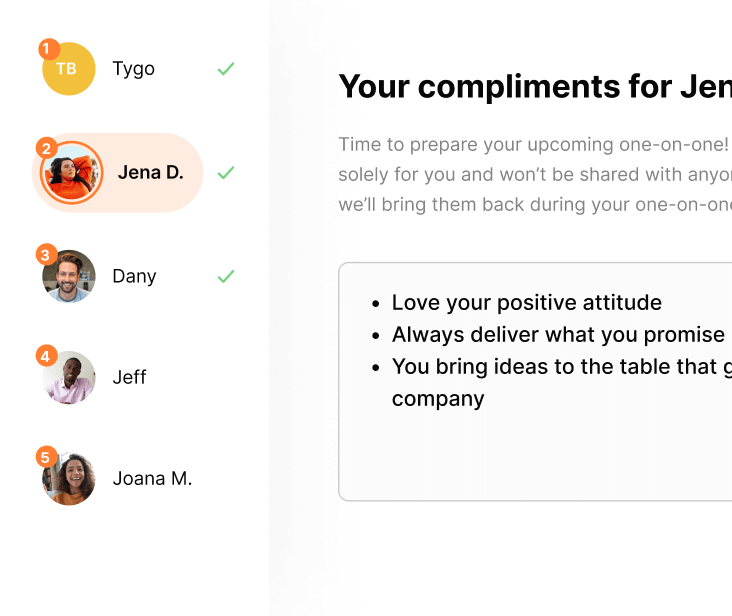Back to Blog
12 must-know models and theories on employee retention
If increasing employee retention is high on your priorities, you’ll know there are various approaches to take. But what is going to work for your organization? In this article, we’ll take a look at 12 models and theories on employee retention so you can understand more about what motivates employees to stick around.
Fancy geeking out on more theories and models? Take a look at these other articles we’ve written on employee motivation theory and employee engagement models.
The eight most popular models and theories on employee retention
1. Maslow’s hierarchy of needs (people management)
Retention driver: Satisfying human needs
This model promotes the importance of considering the basic needs of your employees, including physiological needs, job security, belonging, self-esteem and self-actualization. When employees know that their needs are being met and that their job is secure, they are likely to stay committed.
What it means for retention: Map your employee experience to the pyramid of needs and benchmark how you stack up. Prioritize gaps at the bottom of the pyramid to make the biggest improvements in retention. This is a brilliant article on how to put it into practice.
2. Herzberg’s two-factor motivation-hygiene theory
Retention driver: A sense of purpose and safety
Researcher Frederick Herzberg divided motivational factors of employee retention into two groups (Hygiene & Motivators) back in 1959. Hygiene includes factors like company environment, job safety, pay, and policies. Motivators look at the job itself, ensuring it’s interesting and that employees can progress within their roles. We’ve written more two-factor theory and how to apply it here.
What it means for retention: Teams need to be satisfied with both ‘hygiene’ factors and ‘motivators’ if they are to commit to long-term employment within your organization.
3. The human motivation theory
Retention driver: Satisfying core personal needs
David McClelland’s human motivation theory (also known as the Three Needs theory) suggests that everyone has one of three basic needs: power, achievement, and affiliation. McClelland’s theory implies that employee behavior is significantly impacted by these needs.
What it means for retention: To increase retention, employers must keep on top of satisfying these basic needs for their employees. This means first determining which of these needs are most important to each employee, as these core drivers vary from person to person. This is a good read if you want to understand more about putting this theory in place.
4. The social exchange theory
Retention driver: Relationships and recognition
The social exchange theory believes that all human social behavior and relationships are rooted in an exchange process where people weigh the risks with rewards. When relationships become too risky, people are likely to drop them completely.
What it means for retention: In terms of employee retention, the social exchange theory suggests that if an employee finds their relationship too risky (and lacking in enough reward) they will leave. Simple. TINYpulse has a good read if you want to learn more about what this means for your workplace.
Share fun facts and bond with a team quiz
Have your participants choose from a list of questions they’d like their coworkers to answer about them, before watching as they guess the right answer.
01. Yes
share-fun-facts-and-bond-with-a-team-quiz

Run a guided recognition activity
Have your participants choose from a list of questions they’d like their coworkers to answer about them, before watching as they guess the right answer.
01. Yes
run-a-guided-recognition-activity

Organize a virtual cooking class
Hire a professional chef to help your team cook a delicious lunch or dinner. May be difficult for co-workers with families. To find providers and get tips, read our blog about virtual cooking classes.
02. No
organize-a-virtual-cooking-class

Hire a stand-up comedian
Have your participants choose from a list of questions they’d like their coworkers to answer about them, before watching as they guess the right answer.
02. No
hire-a-stand-up-comedian

No items found
No items found
Table of contents
If increasing employee retention is high on your priorities, you’ll know there are various approaches to take. But what is going to work for your organization? In this article, we’ll take a look at 12 models and theories on employee retention so you can understand more about what motivates employees to stick around.
Fancy geeking out on more theories and models? Take a look at these other articles we’ve written on employee motivation theory and employee engagement models.
The eight most popular models and theories on employee retention
1. Maslow’s hierarchy of needs (people management)
Retention driver: Satisfying human needs
This model promotes the importance of considering the basic needs of your employees, including physiological needs, job security, belonging, self-esteem and self-actualization. When employees know that their needs are being met and that their job is secure, they are likely to stay committed.
What it means for retention: Map your employee experience to the pyramid of needs and benchmark how you stack up. Prioritize gaps at the bottom of the pyramid to make the biggest improvements in retention. This is a brilliant article on how to put it into practice.
2. Herzberg’s two-factor motivation-hygiene theory
Retention driver: A sense of purpose and safety
Researcher Frederick Herzberg divided motivational factors of employee retention into two groups (Hygiene & Motivators) back in 1959. Hygiene includes factors like company environment, job safety, pay, and policies. Motivators look at the job itself, ensuring it’s interesting and that employees can progress within their roles. We’ve written more two-factor theory and how to apply it here.
What it means for retention: Teams need to be satisfied with both ‘hygiene’ factors and ‘motivators’ if they are to commit to long-term employment within your organization.
3. The human motivation theory
Retention driver: Satisfying core personal needs
David McClelland’s human motivation theory (also known as the Three Needs theory) suggests that everyone has one of three basic needs: power, achievement, and affiliation. McClelland’s theory implies that employee behavior is significantly impacted by these needs.
What it means for retention: To increase retention, employers must keep on top of satisfying these basic needs for their employees. This means first determining which of these needs are most important to each employee, as these core drivers vary from person to person. This is a good read if you want to understand more about putting this theory in place.
4. The social exchange theory
Retention driver: Relationships and recognition
The social exchange theory believes that all human social behavior and relationships are rooted in an exchange process where people weigh the risks with rewards. When relationships become too risky, people are likely to drop them completely.
What it means for retention: In terms of employee retention, the social exchange theory suggests that if an employee finds their relationship too risky (and lacking in enough reward) they will leave. Simple. TINYpulse has a good read if you want to learn more about what this means for your workplace.
5. The theory of Organizational Equilibrium (TOE)
Retention driver: Golden Rule - you get what you give
In the Barnard-Simon theory of Organizational Equilibrium, it is proposed that an employee will continue in an organization as long as their perceived contribution to their workplace is on par with the company’s contribution to their life. According to this theory, job satisfaction depends on an employee’s compatibility with their role, predictability of one’s relationships at work, and the harmony of their self-image with their job. Get to know this theory in more depth here.
What it means for retention: The more satisfied your teams are with the contribution they are making vs their compensation, the greater employee retention.
6. The equity theory
Retention driver: High morale
Devised by John S. Adams, a behavioral psychologist, equity theory explains that when an organization is treating an employee in an advantageous way, they’re more likely to be motivated in their work. High morale equals high motivation. Conversely, if employees feel treated poorly, they are likely to become unmotivated and drop in productivity. Learn more about applying this theory with Bright HR.
What it means for retention: The more positively your employees feel about how they are treated in the workplace, the more loyal they are likely to be. Treat your employees well, they’ll stick around!
7. The human capital theory
Retention driver: Employee development
The theory of human capital proposes that companies have the incentive to improve their workforce and business. ‘Human capital’ is an intangible asset that includes qualities such as an employee’s experience and skill. So if you’re developing your employees through education and training, you’re increasing your human capital. The theory suggests the greater your human capital, the greater employee retention. This report provides a helpful look at this theory in detail.
What it means for retention: The more you invest in the development and education of your teams, the better they’ll perform and the more likely they’ll be to stay put.
8. The resource-based employee retention theory (RBV)
Retention driver: Purpose and recognition
Another important employee retention theory is the resource-based theory, which argues that employees who feel most useful to their companies are likely to be most loyal. This theory proposes that by making employees feel valuable, you can reduce retention issues. Everyone wants to feel special after all. Get an in-depth view of RBV here.
What it means for retention: When your teams feel they have a purpose at work and their contributions are valued, retention is likely to remain high.
Four other models and theories worth understanding
It doesn’t stop there; here are four lesser-known employee retention models you might also want to take a look at:
- Job characteristic model - A theory that suggests tasks can be motivator enough to retain employees. Learn more.
- The job embeddedness theory - A theory that suggests the more embedded an employee feels within a company, the less likely they are to leave. See more here.
- Victor Vroom’s expectancy theory - A theory that suggests an employee must believe their tasks are achievable to stay committed to their role. Learn more.
- Job coupling theory - A theory that describes ‘linkage’, ‘fitness’, and ‘sacrifice’ as key determinants in reducing employee turnover. It’s a more complex one to get to know.
How to use software to improve retention
Instead of figuring out retention all on your own, you can use software to take the work off your plate (without ignoring the issue). Employee engagement platforms like Gomada help managers
- measure team metrics and visualize where the team is facing issues
- get an action plan to improve engagement and retention
- run team activities that improve the team with zero effort for the manager
You can learn more about Gomada here or take a closer look at all virtual engagement solutions in the market.
Interested in learning more about employee retention and keeping employee engagement high? Take a look at our other articles:
- 2022/2023 employee engagement statistics: trends, stats + charts
- The absolute best employee engagement apps
- Employee engagement solutions: 10 platforms to consider
- Ranked by our team: The 35+ best virtual team building activities
- 29 simple & fun team building activities for work
Subscribe to get our latest updates
Subscribe to get our latest updates




.jpg)

.jpg)